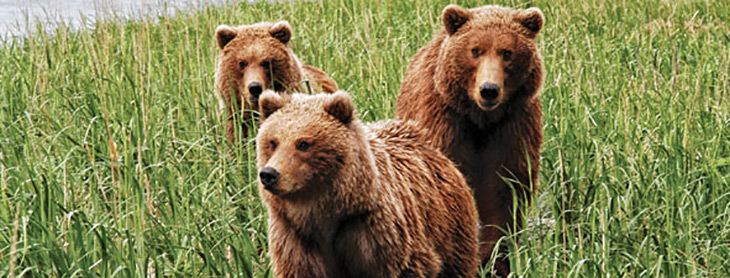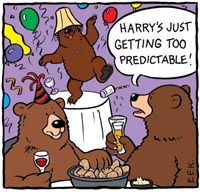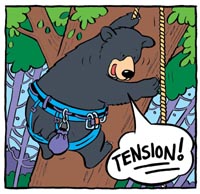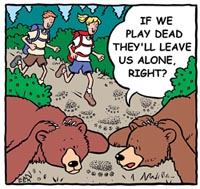
” The best thing people can do for bears is replace misconceptions with facts.” – Dr. Lynn Rogers
Bears have fascinated humans for millennia. As one of the most adaptable and versatile mammals on earth, their behaviour stirs fear, awe, wonder, and curiosity in us. Unfortunately, there are still many myths surrounding the lives and behaviour of bears that negatively impact our relationships with them.
Stories of ferocious attacks by blood-thirsty bears on defenceless hikers make great lead stories in the media. The overwhelming sense conveyed in these stories is that bears are dangerous, mean creatures that are an extreme threat to people in any circumstance. This, of course, is inaccurate at best and unhelpful at worst.
Another commonly held myth is that bears are cuddly creatures that resemble the teddy bears we owned as kids. While there is no doubt that bears have the power to trigger children’s imaginations, it is important that the stories we share with our children be based on facts rather than fantasy.
It is important to dispel both myths – the one based on fear, and the other based on a misplaced belief that bears are tame cuddly animals.
Bears are intelligent and resourceful wild mammals that deserve our respect. A greater knowledge of the behaviour, ecology and habitat needs of bears is crucial if we are to learn to co-exist peacefully with these magnificent creatures.

Myth #1: Bears are unpredictable
Fact: Bears use body language and vocalizations to show their intentions. Learning about bear behaviour can be beneficial to people who live or recreate in bear country.
Myth #2: Bears can’t run down hill
Fact: Bears can run more than 60 kilometers an hour, and they can do it up hills, down hills or along a slope. To put that in perspective, that’s 15 m/sec or 50 ft/sec – more than twice as fast as we can run. In fact, a bear can outrun a racehorse over short distances but has little endurance.
Myth #3: A bear standing on its hind legs is about to charge
Fact: Actually, a bear standing on its hind legs is just trying to better identify what has caught its attention. As I’m sure you’ll agree, it’s much easier to see, hear and smell things from a standing position, than down on all fours.
Myth #4: Once a bear has tasted human food, he won’t eat wild food any more
Fact: Bears prefer natural, wild food unless it is difficult to find and human food is too easy to get. Even bears that regularly eat human food/waste
still eat natural foods whenever they’re plentiful. Conflicts usually increase when natural foods run out – a good time to be more vigilant of bear attractants on your property; such as bird feed, pet food, fruit trees/berry bushes, barbecue grease and compost. Click here to learn more about how to become Bear Smart.
Myth #5: Bear bells are the best way to avoid a surprise encounter
Fact: It’s best to alert bears of your presence by talking loudly, singing songs or breaking sticks. Try to hike in a group, on established trails, during daylight hours. See our Play section for more information.

Myth #6: If a bear charges you, climb a tree.
Fact: Despite all their timidness on the ground, black bears seem to feel more courageous in trees. Bears sometimes kill each other by throwing their opponents out of trees. The bear below has the advantage because the bear above cannot easily hang on and face downward to fight back. Also the lower bear seems confident of these advantages and some bears have even come up trees after people who thought climbing was prudent. Grizzlies, too, can climb – perhaps not as quickly, but they have been known to attack people who climbed trees to escape. See our Play section for more information.
Myth #7: Bears are carnivores.
Fact: Although classified in the order carnivora, grizzly and black bears are omnivores because they eat both plants and animals. Only a small percentage of their diet consist of meat, which includes fish, insects and other mammals (the exact percentage is dependant on the type of food is available in their habitat).
Myth #8: Bears have poor eyesight
Fact: Bears see in colour and have good vision similar to humans. Their night vision is excellent and they are particularly attuned to detecting movement. Like many animals, bears’ eyes have a reflective layer called the tapetum lucidum lining the back of the eyeball. This layer reflects light back through the retina, allowing light to stimulate light-sensitive cells in the retina a second time, thereby improving night vision. This is what gives dogs, cats and many nocturnal animals that distinct, bright green eyeshine when they are flashed with a light at night.
Myth #9: Bears that wander into inhabited areas such as campsites, rural towns or cottage communities are dangerous
Fact: It is nearly impossible for a bear to make its daily excursions without walking through someone’s private property. Bears may travel hundreds of kilometres in their search for food. If you have stored your food and garbage properly, the bear will likely move on. Remember, problem bears aren’t born, they’re created through mismanagement of human food and garbage. If bears are hanging around, something is attracting them. Removing the attraction will usually solve the problem.

Myth #10: Shooting or relocating a ‘nuisance’ bear will solve the problem
Fact: Removing the bear and not the attractant will only create an opportunity for another bear to move in, creating a vicious cycle of conflict and killing.
Myth #11: Carrying a rifle is safer than bear spray
Fact: A person’s chance of incurring serious injury from a charging grizzly doubles when bullets are fired versus when bear spray is used (Dr. Stephen Herrero). Those injured defending themselves with bear spray experienced shorter attacks and less severe injuries than those who chose to use firearms (US Fish and Wildlife Service). Click here to read the full report. Bears are actually attracted to bear spray residue if it is sprayed on the ground or on objects. Never spray it around a tent or on yourself. When used defensively, bear spray must be sprayed directly in the attacking bear’s eyes or nose. Click here for more information.
Myth #12: One of the most dangerous encounters is getting between a mother black bear and her cubs
Fact: Because black bears can tree their cubs, it is rare for them to attack a person in defence of cubs. However, if you are anywhere near a mother grizzly’s cubs, she might very well perceive you as a threat. The chances are good that she will just bluff charge and stop well short of physical contact. You need to do whatever you can to show her that you are not a threat, otherwise the consequences could be tragic. Be quiet, make yourself smaller and retreat.
Myth #13: People traveling in bear country are often attacked
Fact: Bear attacks are extremely rare. Although there are thousands of human-bear encounters every year, only a very few result in personal injury. Most bears will actually retreat before you are even aware of their presence. It is still important, however, to stay alert and know what to do.
Myth #14: It is dangerous to go into bear country when menstruating
Fact: Current evidence suggests that menstruation does not increase the likelihood of an attack by a black or grizzly bear, but tampons are recommended over pads. They may be disposed of by burning and then packing out the remains.

Myth #15: Play dead during an attack.
Fact: Playing dead will work if you’re being attacked by a mother grizzly defending her cubs. But it is the wrong thing to do if you’re being attacked by a predatory bear. If a bear attacks (particularly a black bear) in an offensive manner and physical contact is made, fight for your life. Kick, punch, hit the bear with rocks or sticks or any improvised weapon you can find. A predatory bear usually stalks its prey and attacks from behind. It is often silent and the bear does not exhibit any defensive behaviors like huffing or slapping the ground. Its ears may be laid back and its head held low, with its intent focused directly on you. See our Play section for more information.
